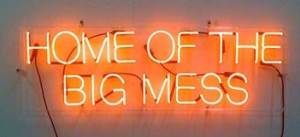Bookkeeping Help: Fixing Your Chart of Accounts
 You can think of the chart of accounts as your accounting foundation, and a lot of people have foundation problems! The chart of accounts, or COA, is the list of places you can put your money.
You can think of the chart of accounts as your accounting foundation, and a lot of people have foundation problems! The chart of accounts, or COA, is the list of places you can put your money.
The goal for your COA is that it should be as detailed as you need to give you quality information. At the same time, it shouldn’t be bogged down in detail that doesn’t add value but does add to the effort of doing your books. As you may have deduced from that, there is no one size fits all, standard chart of accounts (although sometimes people will claim otherwise).
The chart of accounts is always the first place I look when evaluating a new business client and it tells me a lot in a very quick glance. I can instantly see if the balance sheet account balances are positive or negative, how many accounts there are overall, how they are named, if they use sub-accounts, if they use account numbers and just overall how organized and logical it is.
A well-ordered chart of accounts that makes sense and is logical to anyone looking at it for the first time is a good sign. The messier it gets, the more likely it are there are errors buried in the numbers and problems that need to be accounted for.
Does it feel like your books take forever to do each month? It might be your chart of accounts- the messier it is and the less efficiently it is set up relates directly to the time it takes to get your bookkeeping done. It doesn’t have to be like that!
Since the COA is never going to be cleaner and more correct than when you start the business, this is the best time to ensure it is set up right.
The default COA from QuickBooks is a good place to start. You can modify sparingly to fit your business. The bigger and more complex the business, the more complicated your COA can be, although it doesn’t necessarily have to be.
Here are the things we most often see wrong with the chart of accounts:
- Inconsistent use of account numbers. For the vast majority of small businesses, account numbers are not helpful and actually can slow you down quite a bit. They are a tool for big company accounting – “big” as in over 50 employees and millions in revenue with many different departments and managers, etc. If you do use them, use them using the QuickBooks function for them, not by just typing a number in front of the account name as this is impossible to fix except one at a time. And if you do use them, use an account number on every account, not just most.
- Old accounts. If you are no longer using an account, make it inactive or hide it. If you never used an account, delete it. There are a few QuickBooks won’t let you delete, but otherwise get rid of it. This is especially true of old bank accounts, credit card accounts or anything else appearing with a balance on the balance sheet. If the account is no longer active in real life, zero it out in QuickBooks and make it inactive.
- Too specific accounts. Meals and Entertainment is a standard account in most businesses. Some people want to split Meals as one and Entertainment as another- that may make sense for your business. But you never need an account named McDonalds for your restaurant expenses. You can have a vendor named McDonalds and you may eat there twice a day every day, but your account names should not name names.
- Specific dates. These should not be in your COA. For example, you can have an account called State Taxes but you don’t want one called State Taxes 2014. When are you ever going to use it again? Anything that is going to expire of its own accord, only be used once or twice or is specific rather than generic, is almost always to be avoided.
- Too granular accounts. Office Supplies is a standard account in most businesses. Some people then create an Office Equipment account, thinking they will use that when they buy a printer or calculator or something. This is already going to potentially trip you up, because where does toner go? It is used with the office equipment, but it isn’t equipment itself, really. Now what if you added Office Expenses, Office Supplies Reimbursement, Office Printing and Office Supplies- Executive. How long would you have to stop and think about where to put an expense every time someone went to Staples? And would all this slicing and dicing actually help you figure anything out that would be useful? Not likely.
- If you can’t instantly decide into which of two accounts something should go, you probably have too many accounts that are similar. Start merging, renaming and generally scaling back on your inclination to add accounts rather than pick from what you have. Just this one change can make a big difference in how fast you can do your bookkeeping. And the same thing goes for income, not just expenses. If you aren’t gaining any useful info from splitting your income into tons of segments, don’t do it. Especially if you already have the exact same info logged somewhere else. Fewer accounts is generally better.
- Using accounts incorrectly. If you are keeping track of loans in an equity account, using a bank account for a credit card, tracking expenses with negative income entries or anything else weird, you are going to create headaches for yourself. Each account type works a certain way, and while you can force them to do other things, you are going to end up with very odd looking financial statements and a much higher likelihood of having errors in your books.
- Relying heavily on miscellaneous accounts. If you are dropping more than 10% of all your entries into uncategorized, miscellaneous or similar types of accounts on your first pass, you aren’t doing it right. There really should be very few transactions that aren’t easy to classify and only those handful should fall into the unknown account. Even 10% is really high – at the end of a year, well under 1% of your total expenses should be in this type of account and really it’s better if none is left unclassified.
Bottom Line Solution:
Go through your chart of accounts with a fine tooth comb. Can you instantly decide what kinds of expenses go into what accounts? If you find places you hesitate, or which could go both ways, you probably just found a place you can consolidate.
If you see any of the issues listed in the bullet points above, be ruthless in simplifying and cutting out things you don’t need.
A well-organized chart of accounts is going to make doing your books faster and more painless. And the opposite is true- the longer and more complicated it is, the harder and slower the books will be to finish.
Take the time now to edit names, merge two or more accounts into one and delete unused or seldom used accounts. Adding more is easy, so start with less and try to only add when there is absolutely no way to put something in any of the existing options. If you do this, your chart of accounts will become a solid foundation for the rest of your accounting.





